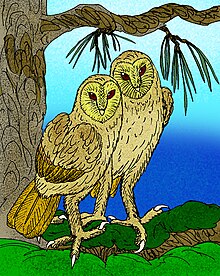Tyto pollens
| Tyto pollens | |
|---|---|
 |
|
| Artist's reconstruction | |
| Scientific classification | |
| Kingdom: | Animalia |
| Phylum: | Chordata |
| Class: | Aves |
| Order: | Strigiformes |
| Family: | Tytonidae |
| Genus: | Tyto |
| Species: | †T. pollens |
| Binomial name | |
|
Tyto pollens Wetmore, 1937 |
|
Tyto pollens, also known as the Andros Island barn owl, Bahamian barn owl, Bahamian great owl, or Chickcharney, is an extinct, 1 metre (3.3 ft) tall, burrow-nesting, flightless barn owl that lived in the old-growth pineyards (Caribbean Pine forests) of Andros Island in the Bahamas. When the island was colonised by Europeans and their slaves in the 16th century, the owls coexisted with them until the forests were felled. The destruction of the original forests may have led to the extinction of the species.
Scholars believe that T. pollens inspired the legend of the Chickcharney, a mischievous, bird-like dwarf that was said by early settlers to haunt the forests of Andros. According to legend the Chickcharney had red, glowing eyes, three-toed feet, and a head that could rotate in any direction.
...
Wikipedia

